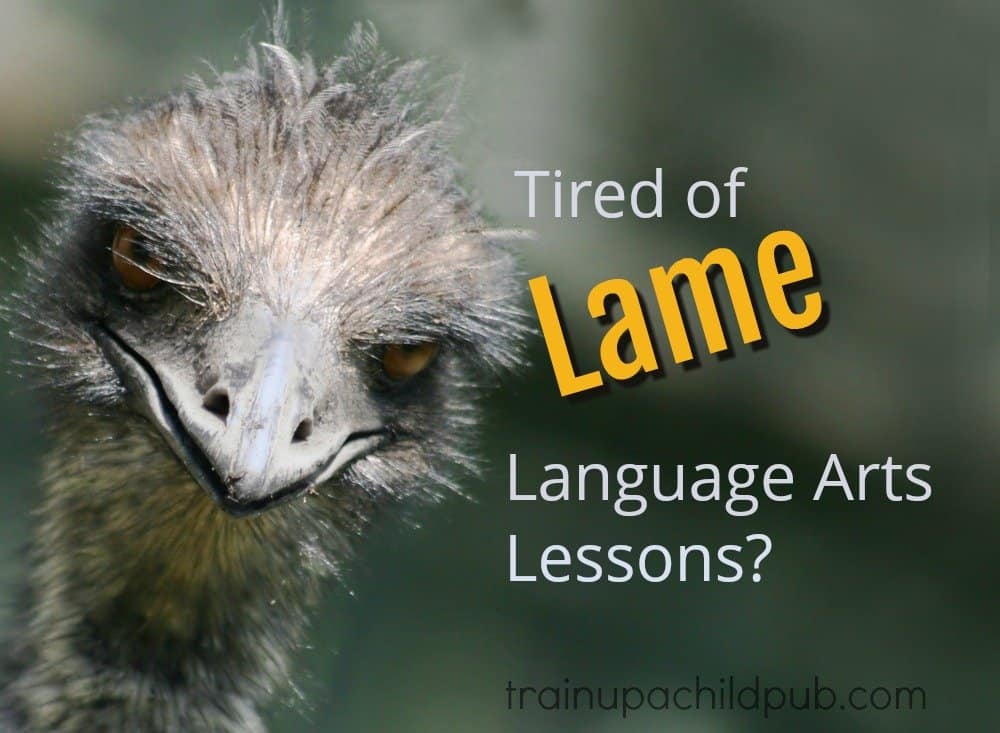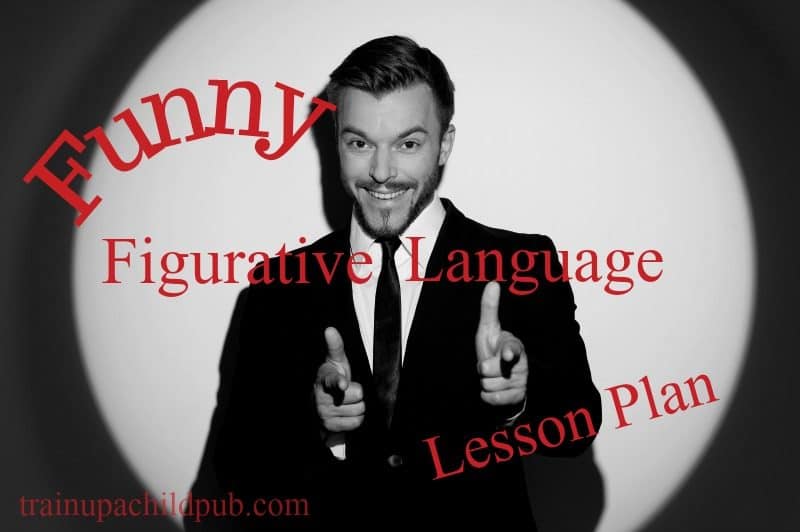Funny Figurative Language Figurative Language for Saying Someone Is Funny

He slouched at the table, pencil in hand. But instead of working on his worksheet (yawn), he watched a tiny black ant crawling all the way across the windowsill…
Are your kids' eyes glazing over at lame language arts lessons? Then jolt them out of their terminal dreariness with this funny figurative language arts lesson plan!
The benefits of adding humor to your homeschooling
Actually, you might be surprised to know that humor can help children retain what they've learned. You've probably experienced that shared humor can help build community with your kids and family. Even my two-year-old grandson is starting to enjoy joking with the family!
Interestingly, brain research tells us that humor stimulates the dopamine (feel good) reward center of the brain. But according to Sarah Henderson in her Edutopia article, "dopamine is [also] important for goal-oriented motivation and long term memory." She goes on to state that learning research demonstrates that humor relating to the subject you're teaching can help your students remember what they learn! (And fortunately, this applies to your kindergarten and your high school students, as well as everyone in between.)

So if you want to bring homeschooling to life for your kids, using humor is a good way to help you do it. Not only does sharing jokes and silliness a relationship-builder between you and your children. But humor that pertains to what your teaching also helps makes learning stick. Which means you don't have to do as much reviewing and re-teaching. After all, the more effective your teaching is the first time, the better off you are.
Because effective teaching is good time management, allowing you more time to conquer the rest of your responsibilities!

So use the following funny language arts lesson to help your student understand (and remember) figurative language!
A friend sent a post said to have been compiled from English teachers across the country. Supposedly, these English teachers sent in actual sentences gathered from their students' essays. And they're hilarious!
If you'd like to use this lesson, it's best for students from upper elementary through high school. (But if you use it for an upper elementary student I recommend you use about 1/3 of the sentences or break these sentences up into at least three lessons, instead of trying to get through all of these sentences at the same time.)
So if your kids are bored with the traditional language arts lesson or they aren't retaining what you're teaching, use this funny figurative language arts lesson to help learning stick!
Follow these steps:
Part I: First teach or review the definitions of these three kinds of figurative language to your student.
Simile–a figure of speech comparing two things using the words "like" or "as". Example: My love is like a red, red rose. This is the first line of a poem by Robert Burns, found here.
Metaphor–a figure of speech comparing two, unlike things. Example: The name of the Lord is a strong tower. Proverbs 18:10 Brainstorm with your child what the author is saying about the name of the Lord by comparing it to a strong tower.
Analogy –a comparison between two things that are alike in some way. Example: Your body can be compared with a car and food to fuel. A human heart is like a pump. What other analogies can you think of?

Part II: After you've discussed the definitions, then identify the type of figurative language in the following sentences
Instructions: After discussing these three types of figurative language, have your student:
- state which two things are compared in each sentence
- whether each sentence uses a simile, metaphor, or analogy
- rewrite the sentence so that two things are compared with either a simile, metaphor, or an analogy if the sentence doesn't include one of the three. (This is step is better for middle school on up.)
Here are the sentences:
1. Her face was a perfect oval, like a circle that had its two sides gently compressed by a Thigh Master.
2. His thoughts tumbled in his head, making and breaking alliances like underpants in a dryer without Cling Free.
3. He spoke with the wisdom that can only come from experience, like a guy who went blind because he looked at a solar eclipse without one of those boxes with a pinhole in it and now goes around the country speaking at high schools about the dangers of looking at a solar eclipse without one of those boxes with a pinhole in it.
4. She grew on him like she was a colony of E. Coli, and he was room-temperature Canadian beef.
5. She had a deep, throaty, genuine laugh, like that sound a dog makes just before it throws up.
6. Her vocabulary was as bad as, like, whatever.
7. He was as tall as a six-foot, three-inch tree.
8. The little boat gently drifted across the pond exactly the way a bowling ball wouldn't.
9. McBride fell 12 stories, hitting the pavement like a Hefty bag filled with vegetable soup.
10. From the attic came an unearthly howl. The whole scene had an eerie, surreal quality, like when you're on vacation in another city and Jeopardy comes on at 7:00 p.m. instead of 7:30.
11. Her hair glistened in the rain like a nose hair after a sneeze.
12. Long separated by cruel fate, the star-crossed lovers raced across the grassy field toward each other like two freight trains, one having left Cleveland at 6:36 p.m. traveling at 55 mph, the other from Topeka at 4:19 p.m. at a speed of 35 mph.
13. They lived in a typical suburban neighborhood with picket fences that resembled [a movie star's] teeth.
14. John and Mary had never met. They were like two hummingbirds who had also never met.
15. He fell for her like his heart was a mob informant, and she was the East River.
16. Even in his last years, Granddad had a mind like a steel trap, only one that had been left out so long, it had rusted shut.
17. Shots rang out, as shots are wont to do.
18. The plan was simple, like my brother-in-law Phil. But unlike Phil, this plan just might work.
19. The young fighter had a hungry look, the kind you get from not eating for a while.
20. He was as lame as a duck. Not the metaphorical lame duck, either, but a real duck that was actually lame, maybe from stepping on a land mine or something.
21. The ballerina rose gracefully en pointe and extended one slender leg behind her, like a dog at a fire hydrant.
22. It was an American tradition, like fathers chasing kids around with power tools.
23. He was deeply in love. When she spoke, he thought he heard bells, as if she were a garbage truck backing up.

Part III: Extend the lesson by writing your own (better!) sentences
Instructions: After your student has done the first part of the lesson, you may extend the lesson by having your student rewrite the sentences using better comparisons. Make sure to have your student include all three types of comparisons.
Ideas for related lessons:
- Have your student research Robert Burns, the poet mentioned in Part I. Then have her write a short report or create a PowerPoint or other presentation on Burns' life and poetry.
- Find two other examples of his poetry, and identify similes, metaphors, and analogies.
- Choose a recent piece of your student's creative writing (a paragraph or short piece) and improve it by rewriting it to include figurative language.
- Have your high school students identify and copy 10 other similes, metaphors, and analogies from your children's literature or from the Bible. Instruct your student to write each complete sentence and highlight or underline the figurative language in the sentence. If you have younger students, adjust this number accordingly.
Adding humor to your homeschooling whenever you can, such as with this funny language arts lesson, helps you make learning stick!
![]()
P.S. If you'd like to know about other ways to make learning stick, get my Growth Mindset, Brain-based Learning Checklist!
cooneythujered1941.blogspot.com
Source: https://trainupachildpub.com/funny-figurative-language-lesson/
0 Response to "Funny Figurative Language Figurative Language for Saying Someone Is Funny"
Post a Comment